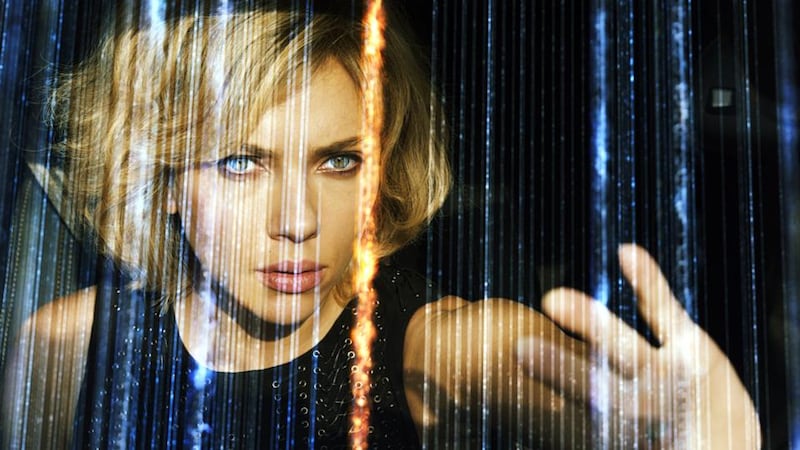Luc Besson is discussing a car-chase scene from his new blockbuster, Lucy. Plus ça change, right?
Mais non.
The sequence in question features a car travelling at light speed: “I speeded up the car until you can’t see it. So then you have to ask, if I cannot see it, is it really there? It’s difficult to integrate Einstein’s ideas of relativity into an entertaining film. It was a great challenge.”

Besson is sitting with me in a Knightsbridge hotel. He's in a buoyant mood and rightly so. His latest film, Lucy, has recently beaten off stiff competition from the Dwayne Johnson vehicle Hercules to open in the number-one spot at the US box office. Industry analysts and pundits have been quick to take note and pronounce that the times, they are a changin'.
Lucy, played by Scarlett Johansson, is one of several female heroines to dominate this summer's tent-pole schedule, and the only one who broaches subjects such as physics and biochemistry.
"Every so often, a film like Inception comes along and all the industry people who think they know everything have to re-think what they know," laughs Besson. "If Lucy does that in a small way, then I'm happy."
Without being too spoiler-y, Besson's latest (and arguably greatest) film, does fun things with space, time and the divine Ms Scarlett, who, in keeping with the tradition of robust Bessonian heroines, faces physical challenges that make the same actor's Black Widow look like Mansfield Park's Fanny Price.
Besson likes his muses tough: he has been previously married to several of his arsekicking leading ladies, notably Nikita's Anne Parillaud, Leon's Maïwenn Besco and The Fifth Element's Milla Jovovich.
"I put them through it because they deserve good roles," he says. "When I made Nikita, people said 'Oh, you can have a girl with a gun'. I opened the door. And I'm very happy that so many women, like Angelina Jolie, have walked through it."
Lucy doesn’t need an armoury. She has herself and an extravagantly imaginative set-up. Even Besson, an artist accustomed to working at breakneck speeds, required a decade to craft the endlessly inventive picture, which turns out to be this summer’s most outré hit by some margin.
“It started 10 years ago,” says the Paris-born film-maker. “I was promoting a movie in small town. And the mayor hosted a dinner and seated a young lady next to me. And I think: I bet it’s the niece of the major – it’s always the niece of the mayor – and she wants to be an actress. So I ask her what she does and she says I’m a professor working on the nucleus of cells that get cancer. I was really not expecting that. I end up having a conversation for three hours and some of that conversation is in the film.”
He admits to embellishing neurological fact with Bessonian fiction. But the film is, he insists, unified by a kernel of hard sci-fi (as opposed to the less fact-friendly soft variety).
“We have one hundred billion cells that can each send 1,000 messages per second. So the number of connections in the human body is insane. And we have no access to this process. I cannot say to my body to do this or that at a cellular level.
“So my question was: ‘What if we could access our bodies at a cellular level?’”
A little bit of neuro-folklore Besson worked with neurologists and academics in order to find some kind of answer. But a little bit of neuro-folklore – the old chestnut that holds “we only use 10 per cent of our brains” – turned out to be narratively useful, too.
“I know it’s not a real theory,” laughs Besson. “It’s just a popular idea from the 1960s. The real science is more complicated. We only use around 15 per cent of our neurons at the same time. Never 100 per cent . But that question is too complicated for a movie. So saying 10 per cent of our brain is easier. After that you have to imagine the steps. So I worked with a couple of professors. The first step, we control ourselves completely. The second step, we can control others. The third step is the control of matter. That’s when the professors said I was getting into the realm of sci-fi. And the final step . . . well, I’d prefer for people to find that out in the movie. But it was very funny to talk with scientists because it can’t be proved or disproved. So they were suddenly mute.”
We shouldn’t be too surprised to discover the film-maker messing with the rules of space and time. Besson’s mind-blowing munificence has often left us wondering: how ever does he do it?
Since the early 1980s, Besson has written 56 films, has directed 21 of them and has produced more than a hundred titles, including Nil By Mouth, I love You, Philip Morris, The Three Burials of Melquiades Estrada, and recent Cannes contender The Homesman. He works outside the system, usually an entire ocean and a continent away from Hollywood, and yet he continues to fashion Euro-accented US chart toppers, including his recent mafia comedy, The Family.
He colours well outside the lines in an industry that have never been more formulaic.
“I protect myself by having my own production company,” he says. “The entire company is not about money. Because you can’t predict what will make money in three years. You can only be honest and protect the heart of the film. People say you have to use this actor today or you have to shoot this way. And I don’t want that. I want to be able to create and try new things. People screamed when Picasso put a nose in an ear. You will never get anywhere if you don’t open doors.”
For all his variability, when we try to picture a Luc Besson film, we're likely to conjure up blistering action scenes; he is, after all, the screenwriter who originated the Transporter films. And Taken 1 & 2. And District 13. And Brick Mansions. Need we go on?
"I react as a movie goer. Sometimes I see big action films and I sit back and admire the technical specs and think 'wow, that's amazing. But then after an hour I start to look at my watch. I start to wonder what I'm doing later. Because I know the game. I know the end. I know the surprise. I'm too old for all that. It's okay when you're 12. But today I need more. I need food. I need something like Lucy that will make me look up things on the internet later."
Besson has long embodied the phrase vive la différence. The son of two Club Med scuba instructors, he had planned to become a marine biologist until an accident, at the age of 17, left him unable to dive. He soon found solace in writing and film-making. By the late-1980s, he had scored international hits with Subway (1985) and The Big Blue (1988) and was a leading figure in what critic Raphaël Bassan called "cinéma du look". Other French critics were less kind and used phrases like "style over substance". But Besson has never been one to cosy up to the establishment.
“I just read a review by a French critic that said ‘Luc Besson does not have a brain’,” he laughs. “It’s just a bunch of people talking so I don’t care. You’re talking about 15 or 20 people. It’s like the idea of religion. It can be a beautiful idea. But then there are guardians of the temple. And they think god wants them to kill people. And cinema is like that.
“Except that first, there’s no temple, and second, the guardians don’t make films. So I don’t mind what they think that’s good. I just want to be true to myself.”











